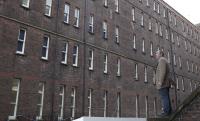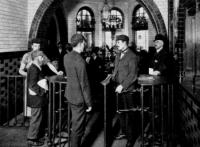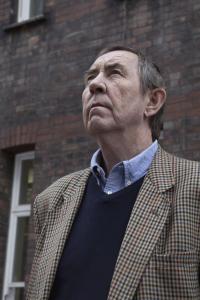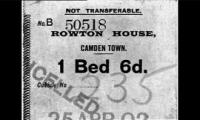TV eye : The men of Arlington
Published in 20th Century Social Perspectives, 20th-century / Contemporary History, Issue 1(Jan/Feb 2012), Reviews, Volume 20
Arlington House in Camden was once the largest hostel in Europe and home to over 1,000 men, many of them Irish immigrants. The redbrick edifice gives no clue to the tragedies and individual histories played out within its walls. (Hotshot Films)
‘They never drank water but whiskey by pints And the shanty towns rang with their songs and their fights . . .’It is perhaps unsurprising that the opening minutes of The men of Arlington should feature a song from the Pogues, a band who embody the London-Irish spirit and who sang of White City, Kilburn, Camden and all the other adopted places of the Irish in London. Of course, while the Pogues often celebrated aspects of the Irish community in London and the city itself, they could also capture the isolation and loneliness of the place.Arlington House in Camden was once the largest hostel in Europe, and home to over 1,000 men, many of them Irish immigrants. It opened its doors in 1905, and the redbrick edifice gives no clue to the tragedies and individual histories played out within its walls. Arlington House is one of the ‘Rowton Houses’, a chain of hostels built in London by the Victorian philanthropist Lord Rowton.

The entrance as it would have appeared soon after the hostel opened in 1905. (workhouses.org.uk)
The men of Arlington looks at the Irishmen for whom this building was home. It contains wonderful archival footage of Camden, Kentish Town and the surrounding areas in the post-war years, when the Irish flooded into London in search of employment, but the documentary also interviews a number of Irishmen for whom Arlington House is still home today. In the opening shots one sees Camden today, and the ethnic melting-pot the area has become, but the documentary stresses that the Irish connection to the area is by no means history just yet.Patrick Kavanagh would spend some time in Arlington as a young man in Camden, writing that ‘many Irish boys made Rowton House, Camden Town, first stop from Mayo . . . the soft voices of Mayo and Galway sounding in that gaunt impersonal place fell like warm rain on the arid patches of my imagination’. While Kavanagh would describe the house as a rather impersonal place, it is clear from the documentary that a strong spirit of community existed within. In ‘Camden town where Paddy lay down’, Arlington could boast of men from every county in Ireland. Alex McDonnell, a former worker at Arlington, recalls the manner in which the corridors would become streets, residents dragging their chairs out and sharing gossip, stories and song there, a world away from the hustle and bustle of Camden Town, just minutes away.

Joe McGarry—one of the three individuals featured in the documentary. (Hotshot Films)
The documentary focuses on three very different narratives, those of Peter, Joe (McGarry) and Seamus. Each has battled his own personal demons. Peter, to whom we are introduced at the outset, has spent over 50 years at Arlington House. When he first arrived, he remarks, the house had no lights or electricity, a far cry from the recently refurbished building of today, which even boasts a for-hire conference hall following a £13 million renovation in 2008. Peter tells us that when he first arrived there were only six baths to serve a total of 180 men.One of the major demons that has long haunted Arlington House is, unsurprisingly, that of drink. Indeed, men were free to drink on the premises, which led to the emergence of ‘drinking schools’, small groupings in which men would alternate days on which to purchase drink for the group. Peter remarks that ‘nowhere else would have them’, and this is quite true, but it is clear that Arlington House not only became a refuge for alcoholics but also produced them. Peter’s story shines through in the documentary, and he is a particularly interesting character in that he has never touched a drink or smoked a cigarette in his life. He carries a great weight on his shoulders, however, in the form of a very troubled childhood, and there is great tragedy in the scenes of Peter recounting this past. Peter’s story is as much a damning indictment of a former Ireland as of a former London. He spent the early years of his life in a variety of Irish institutions. The child of a single mother, he left for London at the age of fifteen. In one of the most moving scenes we see him enter a Catholic church in Camden while it is empty and bless himself, before remarking sadly to the crew that ‘I wouldn’t like to see a priest around me, it brings back memories’. Peter has travelled home to Ireland on numerous occasions recently with the assistance of the Aisling ‘Return to Ireland’ project, but made his first returning visit in 1973. He was met in his native Wicklow by suspicion, inquisitive locals and questioning. He notes that he travelled with the intention of staying for a week but left the day after his arrival. Even at that point there was a stigma attached to being the child of a single mother, not least one who had been raised in a variety of institutions. Like Peter, Seamus is another unlikely resident at Arlington. Educated in a British public school and a one-time owner of a property business, he is a well-educated and well-spoken man who has clearly been lacking luck in life.

A ticket for Arlington House, one of the ‘Rowton Houses’, a chain of hostels built in London by the Victorian philanthropist Lord Rowton. (workhouses.org.uk)
The narratives of these men are deeply personal, of course, but there is a broader narrative here of the story of the Irish community in London and its struggles to relate to a changing city. While the stories of men battling alcoholism and enduring extreme physical conditions in a precarious working environment are emotional and upsetting, the makers of The men of Arlington have also captured the essence of the wonderful work done by those at Arlington House today, and indeed by the Aisling ‘Return to Ireland’ project, which reconnects these too-often-forgotten men with Ireland. The men of Arlington, much like the shocking 2004 Prime Time documentary that examined the plight of the Irish in London, forces the viewer to accept the reality that even after years of economic prosperity, which familiarised the Irish with immigration as opposed to emigration, for many Irishmen London was and still is home. HI
Donal Fallon is co-editor of ‘Come Here To Me’, a blog on Dublin life and culture, http://comeheretome.wordpress.com/.
















